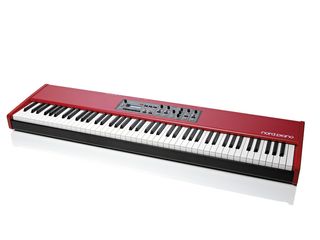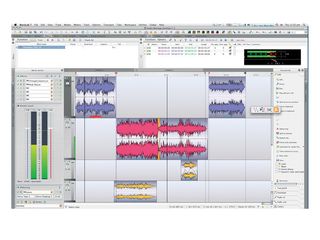The best music tech gear of 2010: synths, DAWs, plug-ins and more

And the winner is...
Has this year been a vintage one for new hi-tech music-making gear? It’s hard to say; in terms of innovation, it would be easy to argue that the class of 2010 hasn’t quite lived up to some of its predecessors, but equally, many of the products that were released during the past 12 months significantly improved upon those that came before them.
So let’s just settle for saying that 2010 has seen the launches of some terrific new hardware and software products and, taking into account the reviews that have appeared on MusicRadar this year, what follows is (in no particular order) a winners’ gallery that showcases the very best of them. Let’s start with the best software synth.

Software synth of the year
ACE felt like a breath of fresh air when it was launched. It’s a semi-modular synth that doesn’t differentiate between audio signals and modulation sources, meaning that you can plug Any Cable Anywhere (that’s where the name comes from). It’s great fun to program, then, and its sounds are bursting with analogue-style charm. And just look at the price: it’s hard to think of another software instrument that offers such good value for money.
5 out of 5
FULL REVIEW: u-he ACE

DAW of the year

Plug-in effect of the year
For better or worse, maximising loudness is a primary goal for many producers when they’re mastering, and FG-X makes a superb job helping them to achieve this. It houses both FG Comp, a master bus compressor, and FG Level, which uses a technology called Intelligent Transient Preservation that delivers what you might call ‘smart saturation’. If you want to make your music loud while preserving punch and dynamic definition, FG-X should be of great interest to you.
5 out of 5
FULL REVIEW: Slate Digital FG-X

Hardware synth of the year
Arturia’s Origin Keyboard was in development for so long that some of us wondered if it would ever see the light of day. You couldn’t miss it when it arrived, though: it’s a mighty 23kg beast that enables you to patch together modules from Arturia’s soft synths and play them on a high-spec keyboard. OK, you probably can’t afford it, but in these days of austerity, you have to admire Arturia for releasing a product that prioritises performance over pragmatism.
5 out of 5
FULL REVIEW: Arturia Origin Keyboard

Compact synth of the year
If someone isn’t kind enough to buy you this for Christmas, the monotron is a prime option if you’re looking for something to spend granny’s cheque on. It may have just the one oscillator and look a bit like a jumped-up Stylophone, but the aux input enables you to process external sounds with the juicy filter, and the low price means that everyone now has the opportunity to own at least one genuine analogue synth. You also voted the monotron the music hardware product of the year at the 2010 MIA Awards.
4.5 out of 5
FULL REVIEW: Korg monotron

Stage piano of the year
Clavia has been making moves towards the stage piano market for a while with its Nord Electro series, but the Nord Piano is the real deal. It ticks all the boxes for gigging keyboard players: there’s a playable 88-note fully-weighted keyboard; a selection of great updatable sounds; fine effects; and easy editing. To top all of that off, it looks great and is just about light enough to be carried by one person.
5 out of 5
FULL REVIEW: Clavia Nord Piano

DJ product of the year
If you’re a serious user of Native Instruments’ Traktor software, this is the product you’ve been waiting for. As a controller, it’s both comprehensive and intuitive, enabling you to play a whole set without touching your mouse. What’s more, the S4 is full of audio I/O, so this and a laptop is all you need. It’s not as compact as some of its rivals, so might require an extra stand in the DJ booth, but if you can live with the large footprint (and relatively high price), you certainly won’t be disappointed.
5 out of 5
FULL REVIEW: Native Instruments Traktor Kontrol S4

Computer of the year
The iPad as computer of the year - really? It certainly isn’t more powerful than the latest desktops and laptops - and it won’t replace your Mac or PC - but its achievement has been to make developers and musicians think again (and, yes, think differently) about how they create/use software. The best iPad music making apps simply couldn’t exist on any other current platform, so although Apple’s tablet isn’t yet essential, it’s already changing the game.
4 out of 5
FULL REVIEW: Apple iPad

Compact MIDI controller keyboard of the year
Akai started the year by releasing credible rivals to Korg’s nanoSeries controllers in the shape of the LPD8 drum pad and LPK25 keyboard, but more recently, it’s upped the ante by effectively combining the two products into a single, compact device. As such, the MPK mini is arguably the most comprehensive truly portable MIDI controller you can buy, being feature packed yet small enough to fit into just about any rucksack.
4 out of 5
FIRST LOOK: Akai MPK mini

MIDI controller keyboard of the year
M-Audio knows the business of manufacturing MIDI controller hardware better than just about anyone else, and the 2010 refresh of the company’s Axiom range was an extremely successful one. The semi-weighted keys are great to play; you get faders, knobs and trigger pads; and the DirectLink technology automatically maps controls to those in your DAW. All of which makes the Axiom a great upgrade option or first time all-in-one controller.
4.5 out of 5
FULL REVIEW: M-Audio Axiom 49

Mic of the year
Telefunken might claim that the AR-51 condenser mic comes “at a price anyone who is serious about recording can afford,” but it’s still pretty costly. However, it’s also a top-quality performer and supremely versatile: if you’ve got this in your home studio setup, you’ll be set up to record almost anything - vocals, guitar amps… the lot. As such, it’s an investment that’s well worth making.
5 out of 5
FULL REVIEW: Telefunken Elektroakustik AR-51

Audio interface of the year
Offering just a single channel of audio input/output, One won’t let you record a full band, but if you just want a stylish way of recording and playing back high-quality sound on your laptop, this is a splendid solution. The single knob sets input gain or volume level, and the icing on the cake is a decent built-in mic, making One a great option for the laptop-owning singer/songwriter.
4.5 out of 5
FULL REVIEW: Apogee One

Monitor of the year
Featuring a Corian-front baffle, ribbon tweeter and aluminium foil-fronted woofer, these speakers offer excellent detail and depth in the mid-range in particular. What’s more, they give a brutally honest representation of how your music actually sounds, making them perfect for mixing. You might consider the price to be high, but The Rock is a rival for monitors that cost much more, and as such, is a worthy winner.
4.5 out of 5
FULL REVIEW: Unity Audio The Rock

Audio editor of the year
Steinberg shook the audio editing marketplace up this year by finally adding Mac compatibility to WaveLab, but that’s not all that version 7 has in its locker. There are now four task-specific workspaces, new restoration tools from Sonnox and a rewritten disc burning engine, leaving us with a product that, in terms of both power and flexibility, puts most of its rivals in the shade.
4.5 out of 5
FULL REVIEW: Steinberg WaveLab 7

iOS app of the year
As you’ll know if you’ve been following MusicRadar’s weekly round-ups, iOS music-making app releases have been many and varied during 2010. However, one stands above all others: NanoStudio is a genuine end-to-end mobile DAW that features sequencing, sampling and a synth. It isn’t yet perfect, but if you only want to buy one music-making app for your Apple handheld, this should probably be it.
4.5 out of 5
FULL REVIEW: Blip Interactive NanoStudio
Liked this? Now read: In pictures: the best hi-tech gear of 2009
Connect with MusicRadar: via Twitter, Facebook and YouTube
Connect with Rhythm: via Twitter and Facebook
Get MusicRadar straight to your inbox: Sign up for the free weekly newsletter

I’m the Deputy Editor of MusicRadar, having worked on the site since its launch in 2007. I previously spent eight years working on our sister magazine, Computer Music. I’ve been playing the piano, gigging in bands and failing to finish tracks at home for more than 30 years, 24 of which I’ve also spent writing about music and the ever-changing technology used to make it.

“I didn’t even realise it had synthesizer on it for decades”: This deep dive into The Beatles' Here Comes The Sun reveals 4 Moog Modular parts that we’d never even noticed before

Is Sabrina Carpenter the world’s biggest Teenage Engineering fan? Please, please, please say that it’s true

“I didn’t even realise it had synthesizer on it for decades”: This deep dive into The Beatles' Here Comes The Sun reveals 4 Moog Modular parts that we’d never even noticed before

Is Sabrina Carpenter the world’s biggest Teenage Engineering fan? Please, please, please say that it’s true


![Chris Hayes [left] wears a purple checked shirt and plays his 1957 Stratocaster in the studio; Michael J. Fox tears it up onstage as Marty McFly in the 1985 blockbuster Back To The Future.](https://cdn.mos.cms.futurecdn.net/nWZUSbFAwA6EqQdruLmXXh-840-80.jpg)






